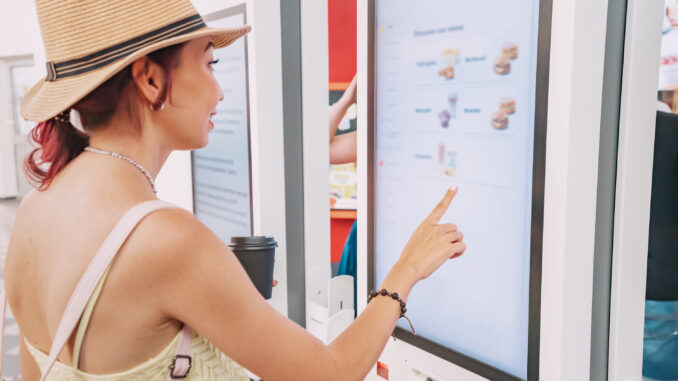
By Tyler Wells, ISV & Strategic Accounts Partner Manager, Americas, MicroTouch -1.13.2024
The restaurant industry has rapidly evolved, and legacy technology is no longer sufficient to meet today’s consumer expectations and support efficient and profitable restaurant operations. However, modern touchscreen solutions put innovation and digital transformation within reach of more restaurants to keep up with industry trends.
Touchscreen technology enables businesses to implement the following:
Self-Service
The labor shortage continues to create challenges for the restaurant industry. The National Restaurant Association reports that 80% of restaurants struggle to fill open positions. The self-service trend that accelerated in the first few years of the decade due to the COVID-19 pandemic is now helping cover tasks that short-staffed operations simply don’t have the time to do. Self-service technology allows guests to place their own orders and make payments, giving managers the ability to reallocate labor to more complex tasks.
Restaurants also benefit from greater order accuracy; customers choose exactly what they want down to the modifiers and sides. And when customer order exactly what they prefer, restaurants also see decreased waste. Furthermore, self-service kiosks enable automatic, consistent upselling, which, according to Kiosk Marketplace, can increase revenues by 12%-22%.
Touchscreens are the most user-friendly interface for a self-service system, allowing customers to browse menus, select items, and complete transactions with just a few taps on the screen.
Back-of-House Automation
Restaurant trends for 2024 include greater automation in food prep areas. While some restaurants are taking automation to the extreme, exploring the value of robotics to prepare orders, others focus on automation to support the kitchen staff. A kitchen display system (KDS) allows restaurants to replace paper chits with digital orders on a screen. This technology eliminates lost orders, confusion, and difficulty prioritizing food prep. The KDS can show each prep station what they need to do in the right order, so everything is ready on time, increasing customer satisfaction.
While KDS isn’t a new concept for restaurateurs, particularly in quick service restaurants (QSRs), many are discovering the advantages of touchscreen systems. A touchscreen eliminates the need for a bump bar to move an order in the system. Instead, staff can move the item directly on the screen. Additionally, the kitchen doesn’t need to find room for the bump bar under the display, saving valuable space.
Streamlined Online Order Pickup
Restaurants that thought the spike in online ordering during the pandemic would decrease afterward are discovering that it’s become a permanent part of their customers’ routines. As a result, they need to institute effective ways to manage this restaurant trend. With the staff already multitasking, it’s difficult to ask them also to cover the pickup counter, particularly when that involves keeping track of third-party delivery personnel in addition to customers arriving to retrieve their orders.
A touchscreen system allows customers or delivery drivers to check in, inform staff they’re waiting, and possibly even get directions to the refrigerated or warming unit, where they can enter a code to pick up their orders without staff intervention.
Online Experiences in Brick-and-Mortar Locations
Consumers interacting with restaurants online more often in the past few years are demanding more when they arrive at a physical location. They want conveniences, such as accessing past orders and loyalty accounts and using mobile wallets to pay.
The right restaurant management system will allow businesses to hyper-personalize customer experiences and give guests access to all the information they need to enhance their dining experiences. Touchscreens help streamline workflows for restaurant staff and provide speed and convenience for customers connecting with that data.
Choose the Right Interface for the Job
Prevalent restaurant trends, both operational and consumer-driven, require that businesses implement technology to manage new processes successfully. It’s vital to provide users with an intuitive interface, i.e., a screen with projected capacitive (PCAP) touch technology that delivers the same experiences as most consumer devices. That ease of use will allow people to seamlessly interact with the technology underpinning new processes and help the restaurant industry move forward with its digital transformation.
 Tyler Wells is the ISV & Strategic Accounts Partner Manager, Americas, for MicroTouch. Since joining the company in July 2021, his focus has been on developing sales and implementing the US distribution strategy. He brings over 14 years of experience in the built-for-purpose computer hardware and sports entertainment industry. Prior to joining MicroTouch, Tyler served as the Global Distribution Sales Manager and Manager of Business Development at Mimo Monitors, Marketing and Business consultant for DYT Solutions, and Inside Ticket Sales for Red Bull. Tyler has a degree in Marketing Management from the University of Wyoming.
Tyler Wells is the ISV & Strategic Accounts Partner Manager, Americas, for MicroTouch. Since joining the company in July 2021, his focus has been on developing sales and implementing the US distribution strategy. He brings over 14 years of experience in the built-for-purpose computer hardware and sports entertainment industry. Prior to joining MicroTouch, Tyler served as the Global Distribution Sales Manager and Manager of Business Development at Mimo Monitors, Marketing and Business consultant for DYT Solutions, and Inside Ticket Sales for Red Bull. Tyler has a degree in Marketing Management from the University of Wyoming.
Are you an industry thought leader with a point of view on hotel technology that you would like to share with our readers? If so, we invite you to review our editorial guidelines and submit your article for publishing consideration.

